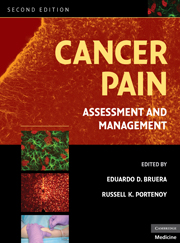Book contents
- Frontmatter
- Contents
- Contributors
- Preface
- SECTION I MECHANISMS AND EPIDEMIOLOGY
- SECTION II EPIDEMIOLOGY AND SYNDROMES
- SECTION III ASSESSMENT
- SECTION IV PHARMACOLOGICAL TREATMENT
- 9 Pharmacology of analgesia: basic principles
- 10 Pharmacogenetic considerations in the treatment of cancer pain
- 11 Pharmacology of opioid analgesia: clinical principles
- 12 Opioid side effects and management
- 13 Antipyretic analgesics
- 14 Adjuvant analgesic drugs
- 15 Neuraxial analgesia
- SECTION V OTHER INTERVENTIONAL STRATEGIES
- SECTION VI REHABILITATION AND PSYCHOLOGICAL INTERVENTIONS
- SECTION VII THE ROLE OF ANTINEOPLASTIC THERAPIES IN PAIN CONTROL
- SECTION VIII PAIN IN SPECIAL POPULATIONS
- SECTION IX DIFFICULT PAIN PROBLEMS
- SECTION X SYSTEMS OF CARE
- Index
- Plate section
- References
9 - Pharmacology of analgesia: basic principles
from SECTION IV - PHARMACOLOGICAL TREATMENT
Published online by Cambridge University Press: 06 July 2010
- Frontmatter
- Contents
- Contributors
- Preface
- SECTION I MECHANISMS AND EPIDEMIOLOGY
- SECTION II EPIDEMIOLOGY AND SYNDROMES
- SECTION III ASSESSMENT
- SECTION IV PHARMACOLOGICAL TREATMENT
- 9 Pharmacology of analgesia: basic principles
- 10 Pharmacogenetic considerations in the treatment of cancer pain
- 11 Pharmacology of opioid analgesia: clinical principles
- 12 Opioid side effects and management
- 13 Antipyretic analgesics
- 14 Adjuvant analgesic drugs
- 15 Neuraxial analgesia
- SECTION V OTHER INTERVENTIONAL STRATEGIES
- SECTION VI REHABILITATION AND PSYCHOLOGICAL INTERVENTIONS
- SECTION VII THE ROLE OF ANTINEOPLASTIC THERAPIES IN PAIN CONTROL
- SECTION VIII PAIN IN SPECIAL POPULATIONS
- SECTION IX DIFFICULT PAIN PROBLEMS
- SECTION X SYSTEMS OF CARE
- Index
- Plate section
- References
Summary
Introduction
The opioid analgesic drugs remain the most effective and commonly used modality for the alleviation of moderate to severe pain due to cancer. The purpose of this chapter is to focus on the pharmacological properties of opioids that form the basis for their use in pain management.
Recently, there has been a dramatic increase in our knowledge of the sites and mechanisms of action of opioids. Pharmacokinetic studies together with the recent discoveries of pain- and opioid-receptor–related genetic polymorphisms have begun to offer us a better understanding of some of the sources of interindividual variation in the response to opioids and to suggest ways to minimize some of their adverse effects. Although there are major gaps in our knowledge of opioid pharmacology, ultimately the rational and appropriate clinical use of these drugs is based on the knowledge of their pharmacological properties derived from well-controlled clinical trials.
Individualized dosage
The fundamental concept that underlies the appropriate and successful management of cancer pain by the use of opioid and nonopioid analgesics is individualization of analgesic therapy. This concept entails selection of the right analgesic, administered in the right dose, and on the right schedule so as to maximize pain relief and minimize adverse effects. This comprehensive approach begins with the nonopioids or mild analgesics for mild pain (see Chapter 11).
- Type
- Chapter
- Information
- Cancer PainAssessment and Management, pp. 167 - 179Publisher: Cambridge University PressPrint publication year: 2009



